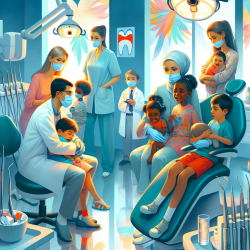As a practitioner in the educational setting, it's always rewarding to see students make progress, especially when it comes to overcoming anxiety and achieving better mental health. Today, I want to share some insights from a recent study titled "Psychometric Properties of Scared-C Scale in a Romanian Community Sample and Its Future Utility for Dental Practice." This research can be particularly useful for those of us working in pediatric dental settings.
The SCARED-C (Screen for Child Anxiety Related Emotional Disorders) is a valuable tool designed to identify anxiety symptoms in children. Validated in a Romanian community sample, the SCARED-C scale shows good internal consistency and reliability, making it a reliable screening tool for child anxiety in various settings, including dental practices.
Key Findings and Implications
Here are some key takeaways from the study and how they can be applied to improve pediatric dental practices:
- Early Identification: The SCARED-C scale helps in the early identification of different types of anxiety, such as separation anxiety, social anxiety, and generalized anxiety. Early detection allows for timely intervention, which can significantly improve treatment outcomes.
- Tailored Interventions: Understanding the specific type of anxiety a child is experiencing can help practitioners tailor their approach. For instance, children with high separation anxiety might benefit from having a parent present during dental procedures.
- Enhanced Communication: Knowing a child's anxiety profile can improve communication between the dentist and the child, making the experience less stressful and more cooperative.
- Reducing Dental Phobia: By addressing the root causes of anxiety, dental practitioners can help reduce dental phobia, making future visits less daunting for the child.
Encouraging Further Research
While the SCARED-C scale has shown promising results, the study also highlights the need for further research. Future studies should explore the scale's convergent and discriminative validity and its sensitivity to current DSM-V criteria. Additionally, applying the scale to a pediatric dental sample could provide more specific insights into its utility in dental practices.
Practical Steps for Practitioners
If you're a dental practitioner or work in a setting that involves pediatric care, here are some practical steps you can take based on the study's findings:
- Implement the SCARED-C Scale: Consider incorporating the SCARED-C scale into your initial patient assessments to better understand their anxiety levels.
- Training and Education: Educate your staff about the different types of anxiety and how to address them effectively. This can make a significant difference in how children perceive and experience dental visits.
- Parental Involvement: Encourage parents to be involved in the process, especially for children with high separation anxiety. Their presence can provide a sense of security and comfort to the child.
- Continuous Monitoring: Use the scale periodically to monitor changes in anxiety levels and adjust your approach accordingly.
Conclusion
The SCARED-C scale is a powerful tool that can significantly improve the way we handle pediatric dental anxiety. By implementing its findings, we can create a more supportive and effective environment for our young patients. This not only enhances their dental health but also contributes to their overall well-being.
To read the original research paper, please follow this link: Psychometric Properties of Scared-C Scale in a Romanian Community Sample and Its Future Utility for Dental Practice.










